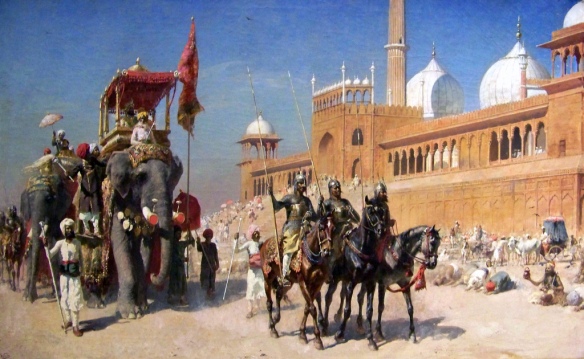The Mughals governed indirectly because they ruled an armed population. The image of India as a peaceful society inhabited by seekers after spiritual enlightenment, now epitomized by the figure of Mohandas Karamchand Gandhi, has never fit the reality of the subcontinent. D. H. A. Kolff has demonstrated that Indian peasant men were normally skilled with weapons and frequently accepted military service far from their home villages. Some of them spent much of their lives as professional soldiers. The Mughals had to co-opt much of this massive indigenous manpower pool. To do so, they had to incorporate its leaders into their ruling class. The process of expansion was the process of incorporation. It brought such local potentates as the rajahs of Amber and Jodhpur into the Mughal system with military followers whose loyalty was to their own masters rather than the empire. The terms of incorporation defined the relationship of the emperor to his officers.
The empire could never have existed, of course, if the Mughals had not had sufficient military superiority to defeat their opponents. The same combination of artillery and mounted archers that enabled the Ottomans to defeat the Safavids, Mamluks, and Hungarians and the Safavids to defeat the Uzbeks gave the Mughals a definite but limited military superiority in the subcontinent. The Mughals, as well as their opponents, expected Mughal victories in battle. There were few major battles in Mughal history for that reason. Sieges were far more difficult, although the Mughals could normally force their opponents to surrender for terms.
The Mughals benefited from the prestige of Babur’s great victories, but they certainly had superiority in both firearms and cavalry. Neither alone would have guaranteed superiority on the battlefield; the combination did. The Mughals neither produced nor employed firearms as well as the Europeans or the Ottomans did. Gunpowder produced in South Asia was consistently inferior, though the reason and significance are unclear. Unlike the Ottomans, the Mughals did not engage directly in the manufacture of gunpowder but purchased it on the open market. They fell behind the Europeans in military technology only in the late seventeenth and early eighteenth centuries, when flintlock muskets sup- planted matchlocks and cast iron artillery became standard. The Mughals produced and employed only matchlocks and brass and bronze guns. Against the foes they faced in South Asia, these limitations made no difference; the Mughals consistently had both more and better firearms than their enemies in the subcontinent. The same proposition held for cavalry.
Mughal superiority in cavalry derived first and foremost from Mughal control of the horse trade. South Asia’s environment did not favor the production of quality horses; cavalry forces had to depend on their import from the northwest, Iran and central Asia, and the west, Arabia. Once the Mughals gained control of Gujarat, they had effective control of these roots. True to their central Asian heritage, they relied primarily on mounted archers; lacking the tradition and practice of this difficult art, their rivals in the subcontinent could not field such a force. The Mughals also made effective use of heavy (shock) cavalry. Their combination of field artillery and cavalry supplanted a military system based on war elephants. The Mughals did use elephants in war, particularly in their early campaigns, but not as their primary striking force.
Unable to defeat the Mughals in battle, their opponents used time and distance against them, defending fortresses and attacking Mughal lines of communication. Mughal expansion thus depended on the ability to take fortresses. Once Akbar demonstrated that ability at Chitor, he and his successors rarely had to complete another siege until the Deccan campaigns. Completing a siege meant enormous costs, in blood and treasure. The Mughals thus had great incentives to permit their adversaries to surrender for terms. At Ranthambor in 1569, Akbar besieged Surjan Hada, the ruler of the small Rajput principality of Bundi. It took the Mughals nearly a month of enormous effort to bring guns to bear against the fort, but once in place they swiftly breached its walls. Surjan Hada then immediately opened negotiations, and Akbar accepted his surrender. Surjan became a Mughal officer and Bundi a subordinate principality of the Mughal Empire. If the Mughals had been able to take fortresses swiftly and easily, they might not have been so ready to offer terms; if their eventual victory had not been certain, their adversaries would not have so willingly accepted them. This definite, but limited, military superiority gave the Mughal polity some of its basic characteristics.
The Mughal difficulty in sieges had tactical and logistic causes. Although the Mughals neither constructed nor conquered fortresses built or adapted to defeat siege guns, such citadels as Chitor and Ranthambor had such strong natural locations that it was extremely difficult to deploy guns against them. The topographic locations of fortresses in South Asia eliminated the need to redesign them to resist siege artillery. But the logistic difficulties were more serious—and certainly more chronic. Except along the rivers of the Punjab and the Ganges and Jumna, water transportation was not available in the subcontinent. Conducting a siege in the Deccan or Rajasthan thus meant operating at the end of a long overland supply line, dragging guns—the Mughal force that besieged Ranthambor advanced at a pace of only three miles a day—and transporting large quantities of food and fodder as well. Because grain could be carried overland only by grain-eating animals, it was difficult to do so in quantity over any distance. Mughal armies thus had to depend on forage. Extended sieges thus denuded the surrounding countryside, often for miles. From a logistic perspective, Mughal forces surrounding fortresses were often as much besieged as the garrisons inside. Especially in the Deccan, opposing field forces interfered with Mughal supply lines, to which Mughal armies had to devote as much effort to protecting as offensive operations. The Mughals thus had tremendous difficulties in both maintaining and ending sieges.
